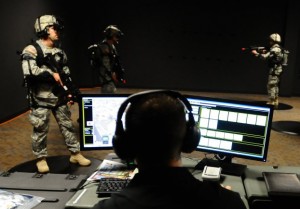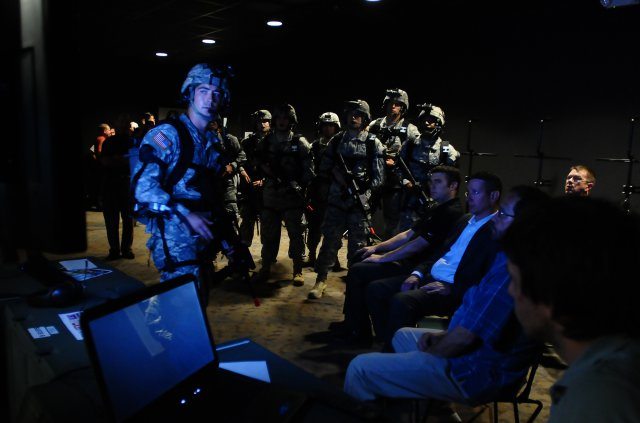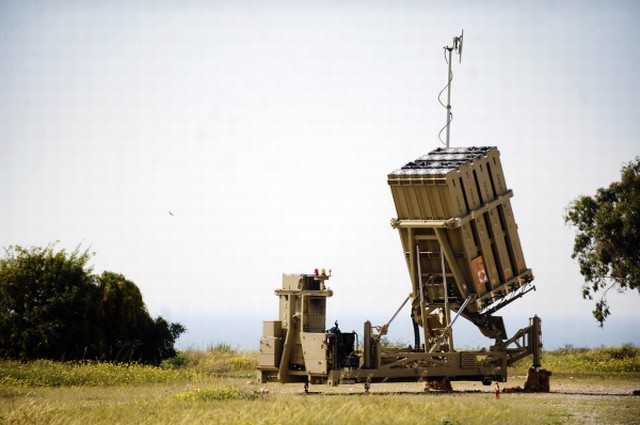The Army is responsible to provide realistic training for individual Soldiers while mitigating risk. With emerging technology of the virtual world, this is becoming a reality.
The first-ever, fully immersive virtual simulation training system for Soldiers is being fielded at Fort Bragg. The Dismounted Soldier Training System will be available for leaders to enhance their Soldiers’ training in a fully immersive, virtual reality environment.
This virtual system allows leaders at the squad level to maintain their squad’s proficiency of their assigned tasks in a timely and safe manner, even in the event new Soldiers arrive to the unit.
“This system gives the power of simulation to the squad in order to close the gap of individual Soldier training and collective training,” said John Matthews, project director, Assistant Project Manager for Close Combat Tactical Trainers. “This system enhances training; it does not replace it.”
The ability to train with this system allows the “reset” time to be cut down, which allows the ability to get more repetitions in a shorter amount of time and the ability to review each mission on a television screen to enhance the after action review process upon completion of each mission.
“You can mold the situation, and you can do it as many times as you want and give younger guys a chance to step up and be leaders. I can see us in the future using this system to conduct rehearsals,” said Sgt. Charles Haywood, team leader, 1st Battalion, 505th Parachute Infantry Regiment, 3rd Brigade Combat Team, 82nd Airborne Division.
With a wide variety of environments, and the ability to insert specific entities into the scenarios, the options for training opportunities are virtually limitless; rehearsals for missions or live-fire exercises are just a couple of examples. Currently, the programmed training environments include mountainous, wooded, and desert. These are intended to simulate places like Afghanistan and Iraq, but are not limited to only these specific scenarios.
“I think everybody accomplished the missions, minus some casualties. But that’s part of [the training]; retrain and try again. [The DSTS] would make part of a well-rounded training cycle, a little bit of this on top of field time can get you different views and situations,” said Haywood.

The Exercise Control Workstation is the brains behind the system and allows the trainer to create, modify, and execute training exercises. This workstation controls each person participating in the training.
Virtual Soldier Multi-function Workstations allow additional virtual Soldiers, vehicles, neutral or opposing forces to “participate” in the training and is controlled by a keyboard and mouse by an additional individual.
The Semi-Automated Forces Works station gives the trainer the option to create additional static items like furniture and buildings or items that are animated such as dogs and birds, inside the virtual world. There can also be modifications made during the scenario like adding an improvised explosive device or more vehicles and combatants.
“You can do things on this system that you can’t [train on] as often here as in the field like air assault missions and capturing [high value targets], whether it be the weather, or having to get ranges,” said Haywood.
Finally, there is an after action review area to allow for an assessment of the scenario. Soldiers can watch as the events unfold with radio communication between squad members and shots fired. This area can be configured to a real-time station that allows visitors to witness what is taking place in the virtual world.
“We see [the DSTS] enhancing fundamental tactics and creating an environment to refine shooting, moving, and communicating in a non-fatal manner to increase the Soldiers’ and squad’s capability and decrease fatalities in theatre,” said Clarence Pape, vice president of Department of Defense Services at Intelligent Decisions.
The initial phase of the fielding will involve delivering three systems to the Fort Bragg Virtual Training Facility and validating them by 1st Battalion, 505th Parachute Infantry Regiment, 3rd Brigade Combat Team, 82nd Airborne Division. Upon being validated, other units on the installation will be able to use them. Additional systems will be delivered to Army installations worldwide for Soldier use in the following weeks.











